Publications
Group highlights
At the end of this page, you can find the full list of publications.
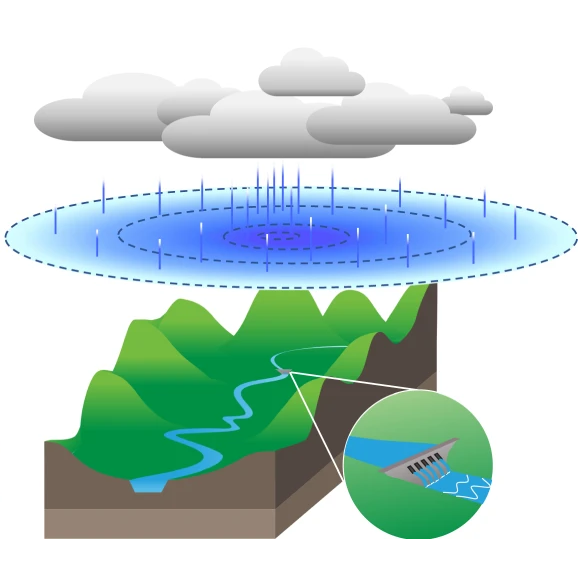
Winter storms in the western U.S. cause billions in damages, but how they’ll change with global warming isn’t fully understood. We show that by mid-century, the strongest winter storms could bring up to 40% more precipitation, with more precipitation at the storm centers. If these changes aren’t accounted for, infrastructure planning could overestimate future storm risks.
Xiaodong Chen, L. Ruby Leung, Yang Gao, Ying Liu, Mark Wigmosta
Nature Climate Change, 13 (2023)

Wildfires in the western U.S. are initiated by different weather and moisture conditions. We used machine learning clustering to improved seasonal wildfire predictions by 10%. Over the past few decades, wildfires have increased due to drier conditions, with some types becoming more common while others, like those linked to wet soil, have declined. This new classification could help better predict and prepare for future wildfires.
Xiaodong Chen, L. Ruby Leung, Lu Dong
J. Geophys. Res.: Atmos., 128 (2023)
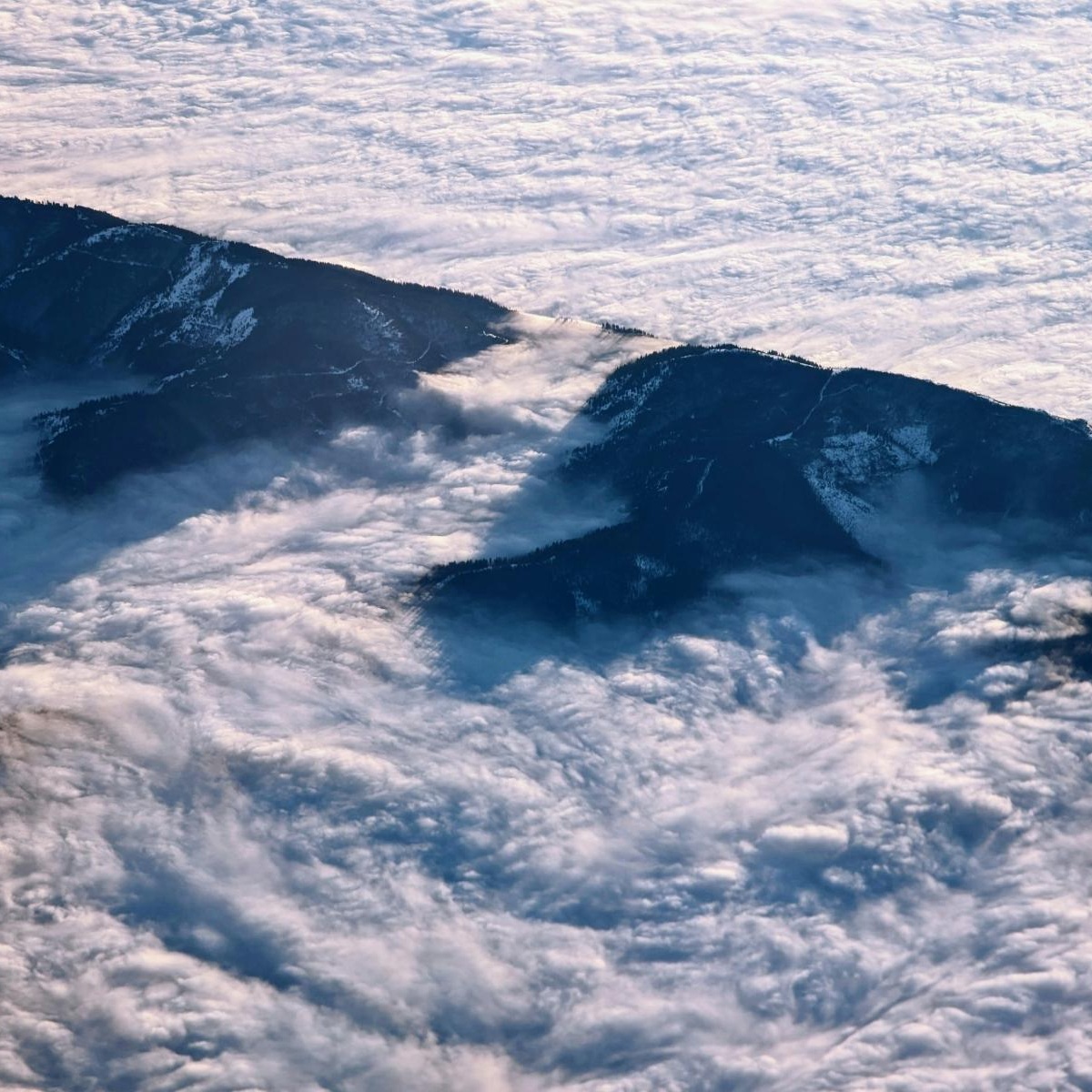
A new weather classification system, WAC-hydro, groups daily weather into 12 types based on rainfall and temperature, helping predict their impacts on snowpack, floods, and runoff in the Pacific Northwest. For example, some weather types increase flood risk through heavy rain and/or melting snow. This system also connects local weather patterns to larger climate trends, making it easier to understand how big-picture climate changes affect regional water systems.
Xiaodong Chen, L. Ruby Leung, Ning Sun
Geophys. Res. Lett., 50 (2023)
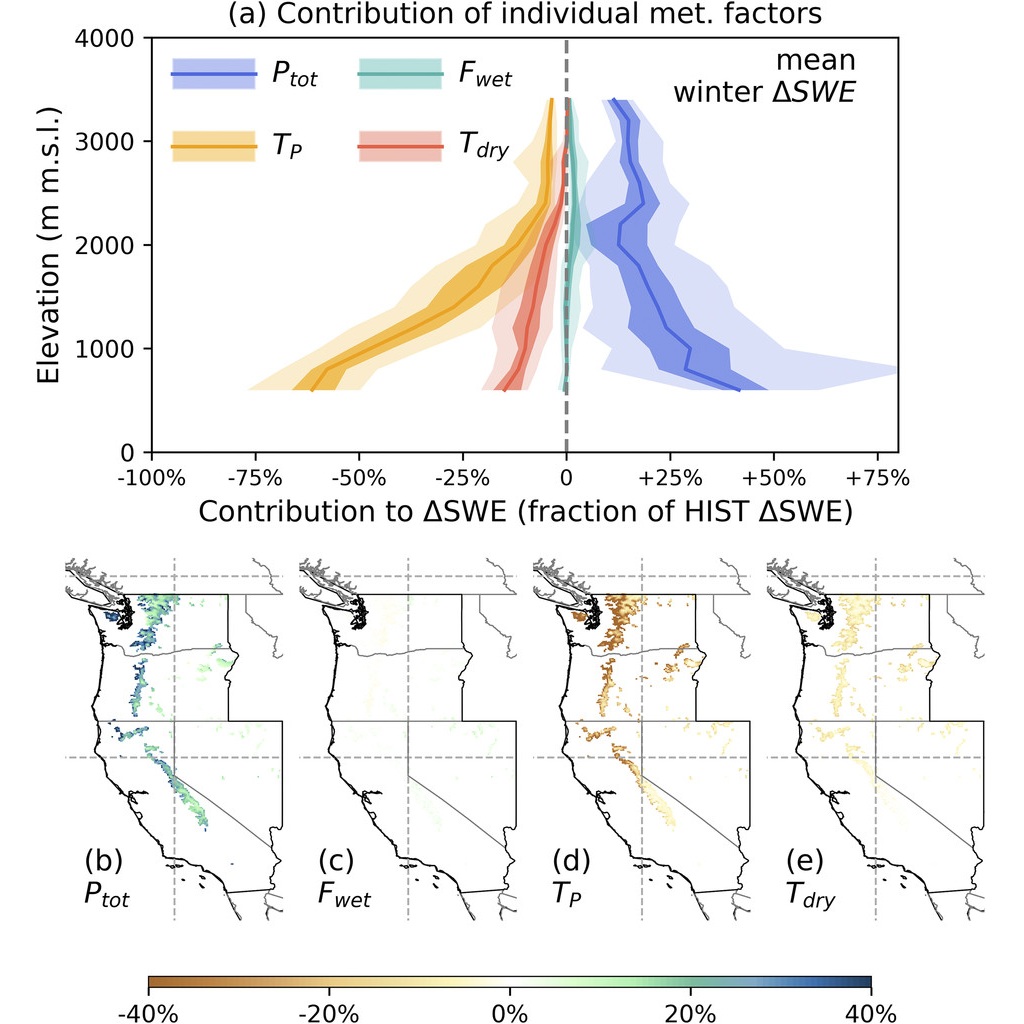
Warmer ocean temperatures near the U.S. West Coast lead to wetter and warmer winters, reducing snowpack in the northern Cascade Mountains but increasing it in the southern Sierra Nevada. This happens because warmer seas boost rainfall and atmospheric rivers, which affect snow differently depending on elevation. The study highlights how local ocean temperatures and atmospheric rivers modulate mountain snowpack, impacting regional water resources management.
Xiaodong Chen, L. Ruby Leung, Yang Gao, Ying Liu

Warmer ocean temperatures near the U.S. west coast can strengthen atmospheric rivers (ARs), making them more frequent, intense, and widespread. This study found that even a small increase in local sea surface temperature boosts AR-related extreme rainfall by 3% per degree of warming. As a result, rising ocean temperatures could lead to more severe ARs and heavier rainfall in the region.
Xiaodong Chen, L. Ruby Leung

Snowpack changes, like melting or accumulation, play a big role in how rainfall affects water flow in the western U.S. A new framework classifies these precipitation-and-snow (PAS) events into five types, showing that 50-90% of rainfall events involve snowpack changes. While snow accumulation happens widely, melting is more common in coastal mountain areas, and atmospheric rivers—though rare—are a major driver of snowmelt during heavy rainfall.
Xiaodong Chen, Zhuoran Duan, L. Ruby Leung, Mark Wigmosta
Geophys. Res. Lett., 46 (2019)
Featured in AGU EOS by Valeriy Ivanov
See DOE highlight
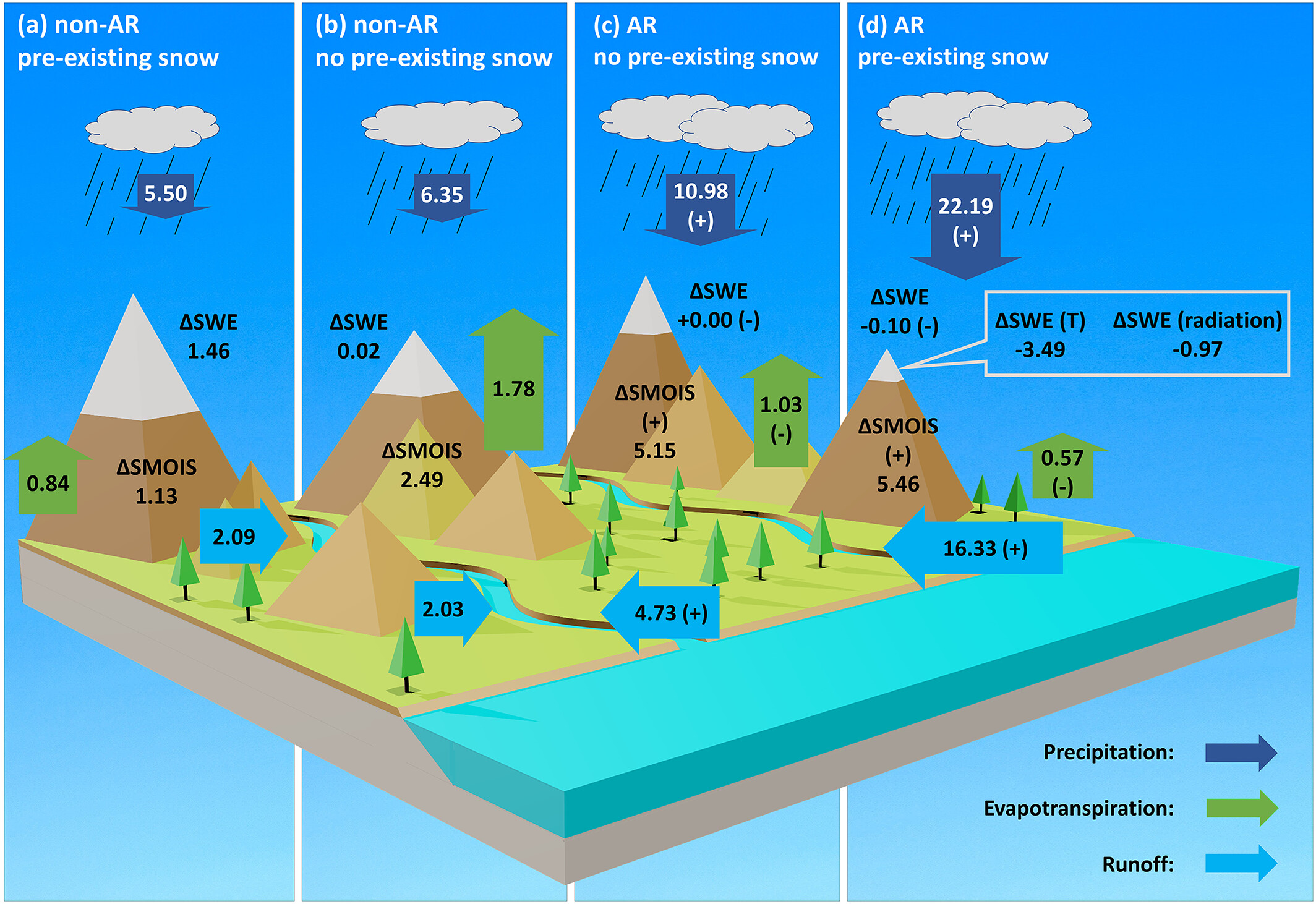
Atmospheric rivers (ARs) bring heavy rainfall to the western U.S., reducing evaporation and speeding up snowmelt due to warmer temperatures and increased heat radiation. They double the runoff in some areas, especially where snow melts quickly, and play a key role in shaping water availability, explaining 30-60% of annual water flow changes. Overall, ARs sharpen the seasonal patterns of water resources, making them a critical factor in the region’s hydrology.
Xiaodong Chen, L. Ruby Leung, Mark Wigmosta, Marshall Richmond
J. Geophys. Res.: Atmos., 124 (2019)
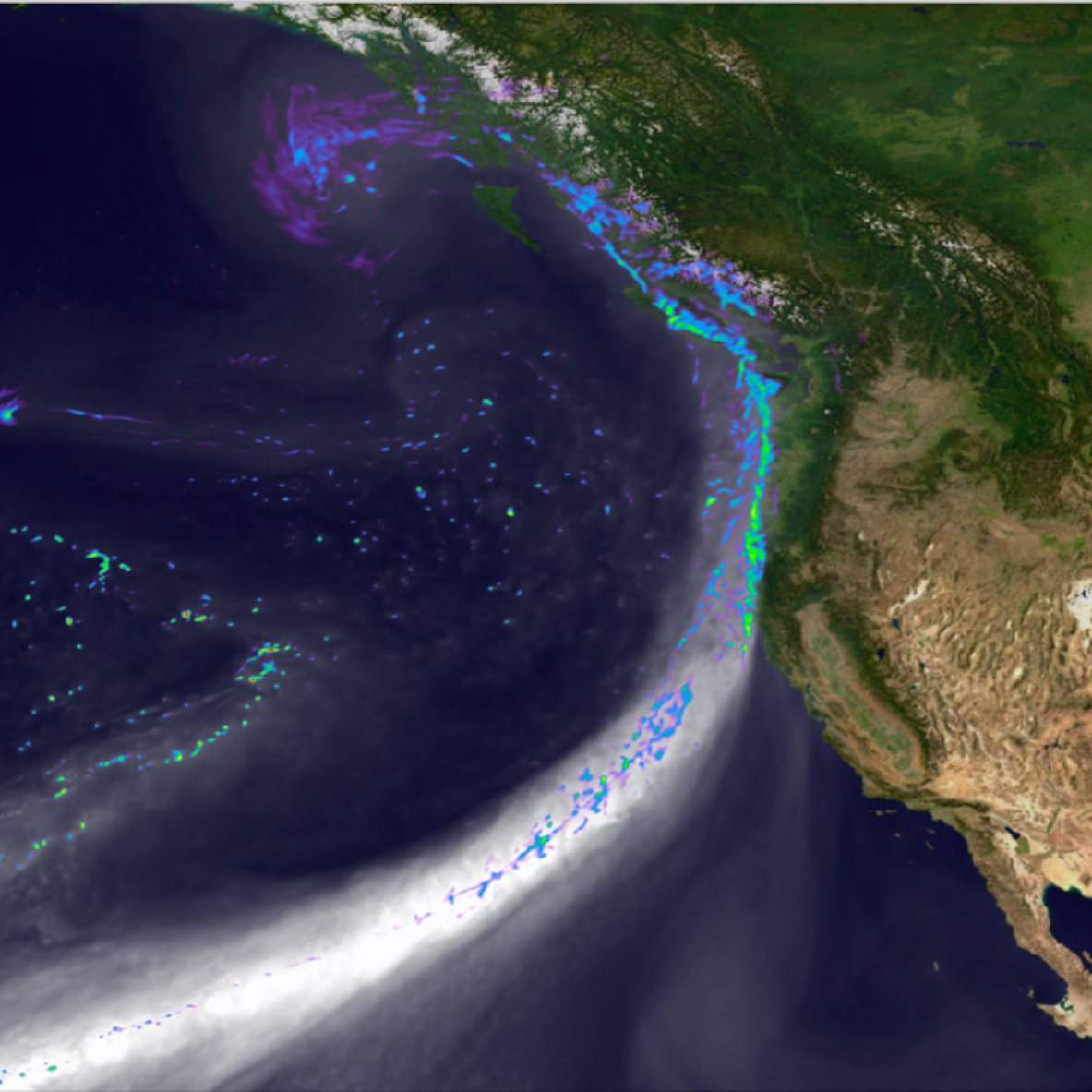
Atmospheric rivers (ARs) are long, narrow bands of moisture that often cause heavy rain and flooding in the western U.S. This study shows that ARs can help predict extreme rainfall, both daily and monthly, and that stronger ARs are linked to heavier rainfall. Using machine learning to focus on the most impactful ARs—those that are long-lasting or intense—researchers, we can better understand and predict the connection between ARs and extreme weather events.
Xiaodong Chen, L. Ruby Leung, Yang Gao, Ying Liu, Mark Wigmosta, Marshall Richmond
Geophys. Res. Lett., 45 (2018)
See DOE highlight
Full List of peer-reviewed publications
Hourly precipitation intensities at 4-km resolution show statistically significant increasing trends from 1991 to 2022 in the CONUS-404 hydroclimate reanalysis
Clément Guilloteau, Xiaodong Chen, L. Ruby Leung, Efi Foufoula-Georgiou
Geophys. Res. Lett., 52 (2025)
Impact of ENSO and MJO on the U.S. Puget Sound Regional Hydroclimate
Xiaodong Chen, L. Ruby Leung, Ning Sun
J. Geophys. Res.: Atmos., 130 (2025)
Seasonal compound renewable energy droughts in the United States
Cameron Bracken, Nathalie Voisin, Youngjun Son, Sha Feng, Osten Anderson, Xiaodong Chen, He Li, Konstantinos Oikonomou
Environmental Research: Energy, 2 (2025)
Amplified mesoscale and sub-mesoscale variability and increased concentration of precipitation under global warming over Western North America
Clément Guilloteau, Xiaodong Chen, L. Ruby Leung, Efi Foufoula-Georgiou
J. Clim., 38 (2025)
More high-impact atmospheric river-induced extreme precipitation events under warming in a high-resolution model
Xiuwen Guo, Yang Gao, Shaoqing Zhang, Wenju Cai, L. Ruby Leung, Jian Lu, Xiaodong Chen, Jakob Zscheischler, Luanne Thompson, Bin Guan, Jonathan Rutz, Chuncheng Guo, Wenbin Kou, Wenxuan Cheng, Huiwang Gao, Lixin Wu
One Earth, 7 (2024)
Characterizing the Uncertainty of CMORPH Products for Estimating Orographic Precipitation over Northern California
Zhe Li, Haonan Chen, Robert Cifelli, Pinging Xie, Xiaodong Chen
J. Hydrol., 634 (2024)
How Might the May 2015 Flood in the U.S. Southern Great Plains Induced by Clustered MCSs Unfold in the Future?
Zhe Feng, Xiaodong Chen, L. Ruby Leung
Earth’s Future, 129 (2024)
Understanding the influence of urban form on the spatial pattern of precipitation
Yanle Lu, Zhou Yu, John D. Albertson, Haonan Chen, Leiqiu Hu, Angeline Pendergrass, Xiaodong Chen, Qi Li
Earth’s Future, 129 (2024)
Sharpening of Cold Season Storms over the Western US
Xiaodong Chen, L. Ruby Leung, Yang Gao, Ying Liu, Mark Wigmosta
Nature Climate Change, 13 (2023)
Antecedent Hydrometeorological Conditions of Wildfire Occurrence in the Western US in a Changing Climate
Xiaodong Chen, L. Ruby Leung, Lu Dong
J. Geophys. Res.: Atmos., 128 (2023)
Weather Systems Connecting Modes of Climate Variabilities to Regional Hydroclimate Extremes
Xiaodong Chen, L. Ruby Leung, Ning Sun
Geophys. Res. Lett., 50 (2023)
More frequent and persistent heatwaves due to increased temperature skewness projected by a high-resolution Earth System Model
Yang Gao, Yubing Wu, Xiuwen Guo, Wenbin Kou, Shaoqing Zhang, L. Ruby Leung, Xiaodong Chen, Jian Lu, Noah S. Diffenbaugh, Daniel E. Horton, Xiaohong Yao, Huiwang Gao, Lixin Wu
Geophys. Res. Lett., 50 (2023)
Potential weakening of the June 2012 North American derecho under future warming
Jianfeng Li, Yun Qian, L. Ruby Leung, Xiaodong Chen, Zhao Yang, Zhe Feng
J. Geophys. Res.: Atmos., 128, (2023)
Summertime Near-Surface Temperature Biases Over the Central United States in Convection-Permitting Simulations
Hongchen Qin, Stephen A. Klein, Hsi-Yen Ma, Kwinten Van Weverberg, Zhe Feng, Xiaodong Chen, Martin Best, Huancui Hu, L. Ruby Leung, Cyril J. Morcrette, Heather Rumbold, Stuart Webster
J. Geophys. Res.: Atmos., 128 (2023)
Moisture Sources of Precipitation in the Great Lakes Region: Climatology and Recent Changes
Zhao Yang, Yun Qian, Pengfei Xue, Jiali Wang, T. C. Chakraborty, William J. Pringle, Jianfeng Li, Xiaodong Chen
Geophys. Res. Lett., 50 (2023)
Response of Extreme Rainfall to Atmospheric Warming and Wetting: Implications for Hydrologic Designs Under a Changing Climate
Jinghan Zhang, Long Yang, Miao Yu, Xiaodong Chen
J. Geophys. Res.: Atmos., 128 (2023)
Contrasting Climatic Trends of Atmospheric River Occurrences over East Asia
Qiang Wang, Long Yang, Yixin Yang, Xiaodong Chen
Geophys. Res. Lett., 49 (2022)
Contrasting Responses of Hailstorms to Anthropogenic Climate Change in Different Synoptic Weather Systems
Jiwen Fan, Yuwei Zhang, Jingyu Wang, Jong-Hoon Jeong, Xiaodong Chen, Shixuan Zhang, Yun Lin, Zhe Feng, Rebecca Adams-Selin
Earth’s Future, 10 (2022)
Climate Leads to Reversed Latitudinal Changes in Chinese Flood Peak Timing
Yixin Yang, Long Yang, Xiaodong Chen, Qiang Wang, Fuqiang Tian
Earth’s Future, 10 (2022)
Response of U.S. west coast mountain snowpack to local sea surface temperature perturbations: Insights from numerical modeling and machine learning
Xiaodong Chen, L. Ruby Leung, Yang Gao, Ying Liu
J. Hydrometeor., 22 (2021)
Meteorological environments associated with California wildfires and their role in wildfire changes during 1984-2017
Lu Dong, L. Ruby Leung, Yun Qian, Yufei Zou, Fengfei Song, Xiaodong Chen
J. Geophys. Res.: Atmos., 126 (2021)
Multiple metrics informed projections of future precipitation in China
Lei Wang, Yun Qian, L. Ruby Leung, Xiaodong Chen, Chandan Sarangi, Jian Lu, Fengfei Song, Yang Gao, Guangxing Lin, Yaocun Zhang
Geophys. Res. Lett., 48 (2021)
Response of landfalling atmospheric rivers on the U.S. west coast to local sea surface temperature perturbations
Xiaodong Chen, L. Ruby Leung
Geophys. Res. Lett. 47 (2020)
Next-Generation Intensity-Duration-Frequency Curves for Climate-Resilient Infrastructure Design: Advances and Opportunities
Hongxiang Yan, Ning Sun, Xiaodong Chen, Mark Wigmosta
Frontiers in Water, 2 (2020)
Soil Moisture and Hydrology Projections of the Permafrost Region - A Model Intercomparison
Christian G. Andresen, David M. Lawrence, Cathy J. Wilson, A. David McGuire, Charles Koven, Kevin Schaefer, Elchin Jafarov, Shushi Peng, Xiaodong Chen, Isabelle Gouttevin, Eleanor Burke, Sarah Chadburn, Duoying Ji, Guangsheng Chen, Daniel Hayes, Wenxin Zhang
The Cryosphere, 14 (2020)
A Framework to Delineate Precipitation-Runoff Regimes: Precipitation vs. Snowpack in the Western U.S.
Xiaodong Chen, Zhuoran Duan, L. Ruby Leung, Mark Wigmosta
Geophys. Res. Lett., 46 (2019)
Parallel distributed hydrological model using global arrays
William A. Perkins, Zhuoran Duan, Ning Sun, Mark Wigmosta, Marshall Richmond, Xiaodong Chen, L. Ruby Leung
Env. Mod. Soft., 122 (2019)
Impact of Atmospheric Rivers on Surface Hydrological Processes in Western U.S. Watersheds
Xiaodong Chen, L. Ruby Leung, Mark Wigmosta, Marshall Richmond
J. Geophys. Res.: Atmos., 124 (2019)
Understanding future safety of dams in a changing climate
Xiaodong Chen, Faisal Hossain
B. Am. Meteorol. Soc., 100 (2019)
Atmospheric River-Induced Precipitation and Snowpack during the Western United States Cold Season
Hisham Eldardiry, Asif Mahmood, Xiaodong Chen, Faisal Hossain, Bart Nijssen, Dennis P. Lettenmaier
J. Hydrometeor., 20 (2019)
Predictability of Extreme Precipitation in Western U.S. Watersheds Based on Atmospheric River Occurrence, Intensity, and Duration
Xiaodong Chen, L. Ruby Leung, Yang Gao, Ying Liu, Mark Wigmosta, Marshall Richmond
Geophys. Res. Lett., 45 (2018)
Understanding model-based probable maximum precipitation estimation as a function of location and season from atmospheric reanalysis
Xiaodong Chen, Faisal Hossain
J. Hydrometeor., 19 (2018)
Probable maximum precipitation in the U.S. Pacific Northwest in a changing climate
Xiaodong Chen, Faisal Hossain, L. Ruby Leung
Water Resour. Res., 53 (2017)
Establishing a numerical modeling framework for hydrologic engineering analyses of extreme storm events
Xiaodong Chen, Faisal Hossain, L. Ruby Leung
J. Hydrol. Eng., 22 (2017)
Terrestrial ecosystem model performance in simulating net primary productivity and its vulnerability to climate change in the northern permafrost region
Jianyang Xia, A. David McGuire, David Lawrence, Eleanor Burke, Guangsheng Chen, Xiaodong Chen, Christine Delire, Charles Koven, Andrew MacDougall, Shushi Peng, Annette Rinke, Kazuyuki Saito, Wenxin Zhang, Ramdane Alkama, Theodore J. Bohn, Philippe Ciais, Bertrand Decharme, Isabelle Gouttevin, Tomohiro Hajima, Daniel J. Hayes, Kun Huang, Duoying Ji, Gerhard Krinner, Dennis P. Lettenmaier, Paul A. Miller, John C. Moore, Benjamin Smith, Tetsuo Sueyoshi, Zheng Shi, Liming Yan, Junyi Liang, Lifen Jiang, Qian Zhang, Yiqi Luo
J. Geophys. Res.: Biogeosciences., 122 (2017)
Revisiting extreme storms of the past 100 years for future safety of large water management infrastructures
Xiaodong Chen, Faisal Hossain
Earth’s Future, 4 (2016)
Are General Circulation Models Ready for Operational Streamflow Forecasting for Water Management in the Ganges and Brahmaputra River Basins?
Safat Sikder, Xiaodong Chen, Faisal Hossain, Jason B. Roberts, Franklin Robertson, C. K. Shum, Francis J. Turk
J. Hydrometeor., 17 (2016)
Variability in the sensitivity among model simulations of permafrost and carbon dynamics in the permafrost region between 1960 and 2009
A. David McGuire, Charles Koven, David M. Lawrence, Joy S. Clein, Jiangyang Xia, Christian Beer, Eleanor Burke, Guangsheng Chen, Xiaodong Chen, Christine Delire, Elchin Jafarov, Andrew H. MacDougall, Sergey Marchenko, Dmitry Nicolsky, Shushi Peng, Annette Rinke, Kazuyuki Saito, Wenxin Zhang, Ramdane Alkama, Theodore J. Bohn, Philippe Ciais, Bertrand Decharme, Altug Ekici, Isabelle Gouttevin, Tomohiro Hajima, Daniel J. Hayes, Duoying Ji, Gerhard Krinner, Dennis P. Lettenmaier, Yiqi Luo, Paul A. Miller, John C. Moore, Vladimir Romanovsky, Christina Schädel, Kevin Schaefer, Edward A.G. Schuur, Benjamin Smith, Tetsuo Sueyoshi, Qianlai Zhuang
Global Biogeochem. Cycles, 30 (2016)
Evaluation of air–soil temperature relationships simulated by land surface models during winter across the permafrost region
Wenli Wang, Annette Rinke, John C. Moore, Duoying Ji, Xuefeng Cui, Shushi Peng, David M. Lawrence, A. David McGuire, Eleanor J. Burke, Xiaodong Chen, Bertrand Decharme, Charles Koven, Andrew MacDougall, Kazuyuki Saito, Wenxin Zhang, Ramdane Alkama, Theodore J. Bohn, Philippe Ciais, Christine Delire, Isabelle Gouttevin, Tomohiro Hajima, Gerhard Krinner, Dennis P. Lettenmaier, Paul A. Miller, Benjamin Smith, Tetsuo Sueyoshi, Artem B. Sherstiukov
The Cryosphere, 10 (2016)
Simulated high-latitude soil thermal dynamics during the past 4 decades
S. Peng, P. Ciais, G. Krinner, T. Wang, I. Gouttevin, A. D. McGuire, D. Lawrence, E. Burke, X. Chen, B. Decharme, C. Koven, A. MacDougall, A. Rinke, K. Saito, W. Zhang, R. Alkama, T. J. Bohn, C. Delire, T. Hajima, D. Ji, D. P. Lettenmaier, P. A. Miller, J. C. Moore, B. Smith, T. Sueyoshi
The Cryosphere, 10 (2016)
Understanding satellite-based monthly-to-seasonal reservoir outflow estimation as a function of hydrologic controls
Matthew Bonnema, Safat Sikder, Yabin Miao, Xiaodong Chen, Faisal Hossain, Ismat Ara Pervin, S. M. Mahbubur Rahman, Hyongki Lee
Water Resour. Res., 52 (2016)
Model estimates of climate controls on pan-Arctic wetland methane emissions
X. Chen, T. J. Bohn, D. P. Lettenmaier
Biogeosciences, 12 (2015)
Assessment of model estimates of land-atmosphere CO2 exchange across Northern Eurasia
M. A. Rawlins, A. D. McGuire, J. S. Kimball, P. Dass, D. Lawrence, E. Burke, X. Chen, C. Delire, C. Koven, A. MacDougall, S. Peng, A. Rinke, K. Saito, W. Zhang, R. Alkama, T. J. Bohn, P. Ciais, B. Decharme, I. Gouttevin, T. Hajima, D. Ji, G. Krinner, D. P. Lettenmaier, P. Miller, J. C. Moore, B. Smith, T. Sueyoshi
Biogeosciences, 12 (2015)
A simplified, data-constrained approach to estimate the permafrost carbon–climate feedback
C. D. Koven, E. A. G. Schuur, C. Schädel, T. J. Bohn, E. J. Burke, G. Chen, X. Chen, P. Ciais, G. Grosse, J. W. Harden, D. J. Hayes, G. Hugelius, E. E. Jafarov, G. Krinner, P. Kuhry, D. M. Lawrence, A. H. MacDougall, S. S. Marchenko, A. D. McGuire, S. M. Natali, D. J. Nicolsky, D. Olefeldt, S. Peng, V. E. Romanovsky, K. M. Schaefer, J. Strauss, C. C. Treat, M. Turetsky
Phil. Trans. R. Soc. A, 373 (2015)
Modeling the large-scale effects of surface moisture heterogeneity on wetland carbon fluxes in the West Siberian Lowland
T. J. Bohn, E. Podest, R. Schroeder, N. Pinto, K. C. McDonald, M. Glagolev, I. Filippov, S. Maksyutov, M. Heimann, X. Chen, D. P. Lettenmaier
Biogeosciences, 10 (2013)
Book chapters
Safety design of water infrastructures in a modern era
Xiaodong Chen
Resilience of Large Water Management Infrastructure: Solutions from Modern Atmospheric Science, Springer (2020)
Application of numerical atmospheric models
Xiaodong Chen, Faisal Hossain, L Ruby Leung
Resilience of Large Water Management Infrastructure: Solutions from Modern Atmospheric Science, Springer (2020)
Infrastructure-relevant storms of the last century
Xiaodong Chen, Faisal Hossain
Resilience of Large Water Management Infrastructure: Solutions from Modern Atmospheric Science, Springer (2020)
non peer-reviewed publications
Maximizing Hydropower Generation with Numerical Modeling of the Atmosphere
Yabin Miao, Xiaodong Chen, Faisal Hossain
J. Hydrol. Eng., 21 (2016)